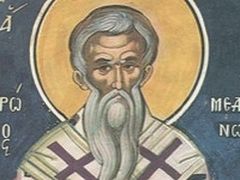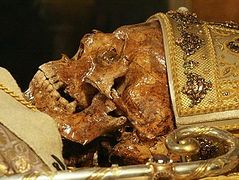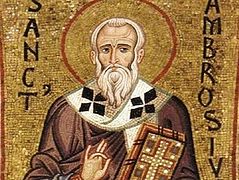The relationship with the state is one of the most important problems in the history of the Church. Since the birth of Christianity, practically every generation of the faithful has sought an answer to this question anew. But among the Christian saints was a man who, with the help of his personal authority, was able to create a new model of relations between Rome and Christians, which led to the collapse of pagan religion, and basically became one of the harbingers of the end of Roman civilization. The Orthodox Church celebrates the memory of St. Ambrose of Milan on December 20.
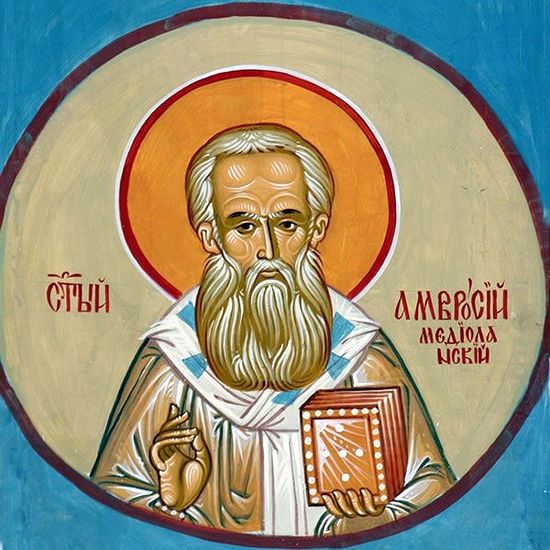 Photo: pravoslavnaya-biblioteka.ru
Photo: pravoslavnaya-biblioteka.ru
Chosen by the mouth of a babe
His name was Ambrose and he was able to successfully combine within himself the classical Roman worldview with Christianity. He became a visible proof that a noble Roman could believe in Christ and that the new faith did not contradict traditional Roman virtues. He was born about 340 AD and died in 397, living only fifty-seven years. In these years, he managed to change both the Church and the empire. He was a lawyer in his youth and then became a prefect in Northern Italy, that is, the second most important person after the emperor, besides the other prefects. His residence was in Milan, the second most important city in the empire after Rome. As a prefect, St. Ambrose was distinguished by justice and strict observance of the law, and therefore in 374, he was appointed arbitrator in the dispute between the Arians and Orthodox, dedicated to the election of a new bishop of Milan.
At the end of the fourth century, this position was highly coveted. After St. Constantine the Great made Christianity first a permitted, and then the preferred religion, a flood of new believers and money poured into the Church. St. Ambrose’s contemporary, the historian Ammianus Marcellinus, describes the carnage with the election of the bishop in Rome in 369: “Damasus and Ursicinus were eager to seize the episcopal place. The parties were divided, and the struggle reached the point of bloody fights and mortal combat between the followers of either side… Damasus won in this contest—thanks to the efforts of the party standing for him. In the Basilica of Sicinin, where Christians met, 137 corpses of those murdered were picked up in one day, and the common folk, who had been in a rage for quite some time, only gradually and little-by-little calmed down.”
Similar bloodshed could have taken place in Milan, and so the conscientious prefect came to the basilica where the election was taking place, to calm the crowd. From the cathedra, St. Ambrose began to call the people to order, and at that time, a child’s voice rang out three times in the church: “Ambrose is a bishop.” It was taken as a sign from above, and, although the candidate wasn’t even baptized and chose to flee the city, after a while he was baptized and made a bishop.
From this moment began a new stage in the life of the former Roman prefect. St. Ambrose studied the Sacred Scriptures and the Holy Fathers diligently, and then began to give homilies in which he compared Biblical texts with the treasures of Roman and Greek philosophy, literature, and history. According to many researchers, he did this not to convince the Romans of the correctness of their teachings, but to stop the process of the destruction of Roman civilization and to convince Christians of the richness of the ancient culture.
The Church in the state or the state in the Church?
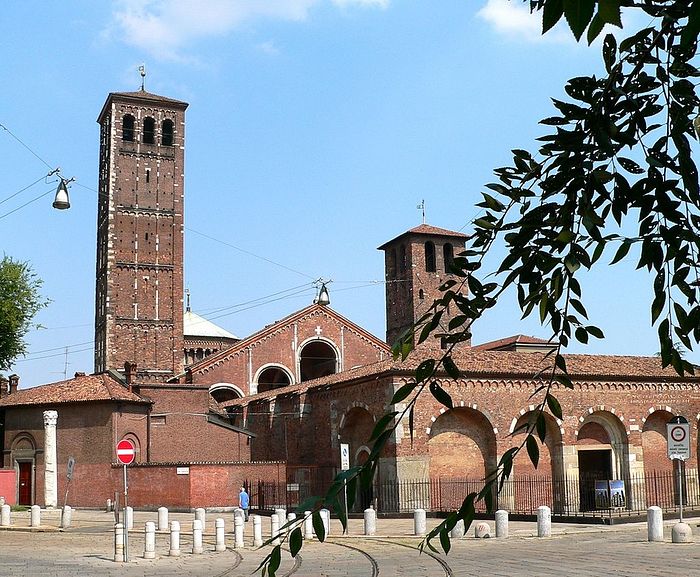 The Basilica of St. Ambrose of Milan, built in 379-386 by St. Ambrose on the place of the burial of early Christian martyrs
The Basilica of St. Ambrose of Milan, built in 379-386 by St. Ambrose on the place of the burial of early Christian martyrs
The Roman Empire entered a phase of decline, while the Christian Church, conversely, was markedly gaining strength. In these conditions, it was necessary to develop ways of interaction between the Church and the emperor. The Eastern and Western Churches took different paths down this road. In Constantinople, the idea of caesaropapism began to develop from the time of St. Constantine the Great, as formulated by the African Bishop Optatus. In his view, the emperor’s power was limited only by God, thus the bishops should obey the commands of Caesar, even in Church matters. Optatus issued a stamped formula for this type of relationship, which the king later used with pleasure both in Byzantium and in Rus’: “The Church in the state, but not the state in the Church.”
Of course, St. Ambrose could not accept such a doctrine. Rome was rapidly changing: The supporters of the old Roman religion felt that their time was running out and St. Ambrose was trying to consolidate the status of Christians in the state, using his personal influence with the emperors.
The culmination of this struggle was the famous dispute about the Altar of Victory, which occurred in the second half of 384. The interests of the pagans were presented by the prefect of Rome Symmachus, while St. Ambrose presented on the Christians’ side. The whole controversy consists of letters addressed to Emperor Valentinian II. The young king wasn’t baptized yet, and therefore Symmachus addressed him with an extensive letter requesting to restore the Altar of Victory in the Senate. The arguments of the Roman prefect basically boil down to toleration, the protection of ancient customs, and the preservation of the traditional Roman religion, which brought glory to the empire: “Everyone has his own customs, his own rites. Divine thought has given different cities different patron gods. The nations each receive their own genius given by fate, as a newborn receives its soul. Besides, men appropriate for themselves the gods for reasons of utility: The meaning of everything is hidden from us, but how do we most correctly come to know the gods if not by recollections and memories of happy events? And if the intervening centuries created the authority of religion, then we must be faithful to so many centuries and follow our parents, who happily followed theirs.”
Symmachus brought forth one of the strongest arguments from the point of view of classical Roman virtues. Since its founding, Rome stood on the veneration of the “fathers”—the patricians. The antiquity of the customs and correctness of their execution was so important that if there was a mistake in the procedure of divination or in the election of consuls, then the election was annulled. Authority passed into an interregnum period, where they had to convene a people’s assembly within five days to elect a king or consul.
In turn, St. Ambrose wrote two letters to Valentinian II. He sent the first before having the text of Symmachus’ letter, while the second is dedicated to parsing his opponent’s arguments. The first epistle contains the Holy Hierarch’s understanding of the place of the Church in the empire: “As all people who are under Roman rule serve you, the earthly emperors and sovereigns, so you yourself serve the almighty God and the sacred faith. Otherwise, salvation cannot be ensured, if everyone does not truly honor the true God, which is the God of the Christians, Who rules all.” This is the idea that the ministry of the priest is higher than that of the emperor, inasmuch as the emperor remains a layman in the Church and in spiritual matters is subject to the episcopate and undertakes to protect the faith by the power of his authority. St. Ambrose was one of the first Western teachers of the Church, who formulated the basis of the greatness of Rome as a Church, which then developed in the medieval disputes between popes and European monarchs. It is precisely from the standpoint of a strong Church that St. Ambrose will then speak to the usurper Eugene and with St. Theodosius the Great—the last emperor who managed to briefly unite the Western and Eastern Roman Empire.
But let us return to the dispute with Symmachus. The Holy Hierarch brings forth another argument, from which it is clear that St. Ambrose did not limit the influence of the Church just to the walls of the parish church. The Senate was a public place with both pagan and Christian senators. The restoration of the Altar of Victory would have violated the rights of the majority of the Senate and would have forced Christians to be in a place where oaths are pronounced and sacrifices are offered to pagan gods, whom he calls “demons and idols.” St. Ambrose clearly shows to the emperor that between the principle of the equality of religions and the support of the Church, the emperor must choose the side of the Christians, inasmuch as he himself must be a Christian. For the first time, the saint begins to use the title “most Christian” in his addresses to the king, investing this epithet with a very definite concept—the defender of the faith, obeying the commands of the Church. St. Ambrose inverts Optatus’ formula, proposing that the state is in the Church, but not the Church in the state.
The Milan bishop also very elegantly refuted the idea of Symmachus and classical Rome that the gods fought on the site of the legions and granted them victory. This was one of the foundational ideas for Roman civilization, and both ordinary soldiers and consuls literally gave their lives for the sake of the satisfaction of the gods; every such victim became a national hero and, in fact, a new god for the Romans. St. Ambrose says that it’s not the gods that brought victory to Rome, but the valor of the soldiers: “Why should I deny that their shrines fought for the Romans? But then again, Hannibal worshiped the same gods! So the gods can choose whom they want.” This last phrase from St. Ambrose is revolutionary in its irony not just for antiquity, but also for the Middle Ages. During the Crusades, both the Franks, who besieged Constantinople, and the Greeks, its defenders, believed that Christ would help only their forces.
St. Ambrose won in the dispute with Symmachus. The Altar of Victory was not restored, but Symmachus respected the bishop and sent him a young man by the name of Augustine who was to become one of the greatest teachers of the Church. This was Blessed Augustine of Hippo, the author of Confessions, The City of God, and other works that make up a golden foundation of Christian Patristics. In turn, St. Ambrose spoke very highly of the talents of Symmachus, and the dispute did not spoil their good relations.
The “gravedigger” of Rome
The highest point of the political influence of the Milan bishop was the repentance of Emperor Theodosius the Great and the subsequent series of decrees outlawing paganism in the empire. It should be noted that this Byzantine emperor long considered himself entitled to interfere in internal Church affairs, to convene councils, and even to forbid Christians from having theological disputes. For the East, with its idea of caesaropapism, this was already normal practice, but for the West, such interference from the king was unacceptable, and therefore the dialogue between Sts. Ambrose and Theodosius was practically inevitable.
Among St. Ambrose’s letters to the kings are several epistles to St. Theodosius, in one of which he again declares the primacy of the Church over the emperor: “If in monetary affairs you consult with your committees, then all the more should you consult with the priest of the Lord in matters of religion.” In the future, the Holy Hierarch often told the king that “porphyry makes people kings, not priests,” and considered the episcopal dignity higher than that of the king.
Such a daring position from St. Ambrose bore its fruit—in 392, St. Theodosius issued a law practically abolishing the entire pagan cult. He forbade any sacrifices (they were equated with an insult to His Majesty), condemned those who worshiped images created by the human hand, and ordered the confiscation of temples and places of pagan worship. The traditional Roman religion came to an end. Ironically, St. Ambrose became one of the “gravediggers” of Rome—a man who loved antique culture and philosophy and desired to introduce Christians to it. A true Roman, he was not only able to speak with the kings on equal terms, but to lay the foundation for the resurrection of antiquity, grafting it to the healthy tree called “Christianity.”

